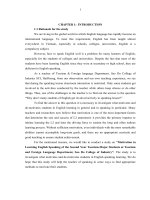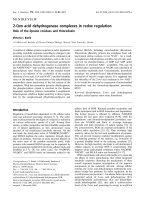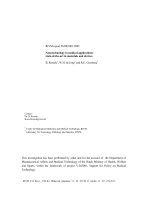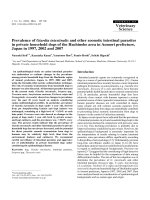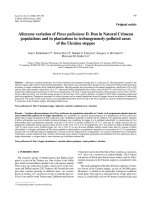Biodiversity in Riffles and Pools of the Mardi and the Vijaypur streams, Pokhara, Nepal: Benthic macroinvertebrate communities
Bạn đang xem bản rút gọn của tài liệu. Xem và tải ngay bản đầy đủ của tài liệu tại đây (364.23 KB, 12 trang )
BIODIVERSITY IN RIFFLES AND POOLS OF THE
MARDI AND THE VIJAYPUR STREAMS,
POKHARA, NEPAL: BENTHIC
MACROINVERTEBRATE COMMUNITIES
Kishor K. Pokharel
ABSTRACT
Macroinvertebrate communities from September 2003 to August 2004
were studied in riffles and pools of the Mardi and the Vijayapur streams,
Pokhara, Nepal. A total of 47 genera (32 from the riffles and 34 from the pools)
belonging to 38 families and 12 orders were recorded. The generic richness was
lower (30 genera) in the Vijaypur stream than in the Mardi stream (38 genera).
Ephemeropteran, dipteran, and trichopteran were found predominant
orders comprising 11, 8 and 8 genera respectively. Heptagenids, baetids and
leptophlebids; chironomids, ceratopagonids and tipulids and hydropsychids,
psychomyids and polycentropodids were dominant sub-groups/families among
ephemeropterans, dipterans and trichopterans respectively. The dominant genera
were, Heptagenia, Rhithrogena and Baetis; Tendipes, Culicoids and Simulium;
Hydropsyche and Psychomyia; Psephenus and Heterlimnius; Octogomphus and
Argia and Planaria among ephemeropterans, dipterans, trichopterans,
plecopterans, coleopherans, odonates and tricladids respectively. The taxa
occurred at both streams and sub-habitats were, Ephemera, Heptagenia,
Rhithrogena, Ecdyonurus, Ephemerella, Baetis, Leptophlebia, Caenis; Tendipes,
Culicoides, Simulium; Hydropsyche, Psychomyia, Psephenus, Heterlimnius and
Planaria. Those occurred only in the Mardi stream (Site 1) were Habrophlebia,
Siphlonurus; Glossosoma, Hydroptila, Leptocerus; Nemoura, Protonemura,
Octogomphus, Argia and Gyraulus convexiculus, whereas, only in the Vijaypur
stream (Site 2) were Centroptylum; Antocha, Psychoda, Tabanus, Agapetus and
Ectopria. The lower taxa richness at the site having urban influence reflects
perturbation of riverine environment due to urbanization and needs measures to
control further deterioration.
Key words: Macroinvertebrates, stream bio-diversity, distribution, riffles, pools.
INTRODUCTION
The invertebrates living on, the bottom of the water body playing a vital
role in the aquatic ecosystem are macro-invertebrates or macro-zoobenthos.
Several investigators have pointed out that many aquatic insects were evolved in
cool lotic waterbodies prior to spreading to warmer riverine and lacustrine
environments (Hynes, 1970; Ward, 1992 and Wetzel, 2001). Some of these biota
form the food of fishes, while others act as predators on young fishes and other
Mr. Pokhrel is an Associate Professor, Department of Zoology, Prithvi Narayan Campus, T.U.,
Pokhara, Nepal.
142 BIODIVERSITY IN RIFFLES AND POOLS OF THE ...
aquatic fauna. Many researchers have focused their attention on the role of these
bottom dwelling invertebrates as fish food, being the most diverse fauna of
running waters (Mohan and Bisht 1991; Allan, 1995), some worked on their
abundance for measuring diversity indices as biomonitors and indicators of water
quality and environmental conditions of lotic waterbodies (Norris and Norris
1995, Dudgeon 1999), some others incorporated them into general models of
structure and function of stream ecosystem (Fisher and Likens, 1973, Cummins
and Meritt 1996) and recent works on riverine macro-invertebrate assemblage
have concentrated on variations in population and community dynamics and
secondary production in response to environmental variables (Minshall et al.
1985, Cummins 1992, Sharma et al. 2004).
Studies on macroinvertebrate fauna have been done by aquatic biologists
(Das, 1971; Walsh et al., 2001). Some works have been performed in Nepalese
waterbodies (Sharma, 1975; Yadav and Rajbhandari 1982; Vaidya et al., 1988;
Ormerod et al., 1994; Brewin et al., 2000; Sharma et al., 2006 etc.). However,
those of the Mardi stream and Vijaypur stream in Pokhara valley probably have
not yet been studied. The Mardi, a snow-fed high altitude stream flowing through
the base of Himalayas and the Vijayapur, a spring-fed mid-hill stream flowing
through the base of Mahabharat hills in Pokhara valley, Nepal represent typical
Himalayan lotic ecosystem with unique physio-hydrological features such as,
high velocity, low or moderate temperature, unstable river-bed substrata etc.
Considering their importance in aquatic ecosystem and lack of literature, present
work aims to explore the macro-invertebrate fauna of these streams.
STUDY AREA
Pokhara, "a beautiful valley of nature's paradise" in centro-western
Nepal Himalaya, has many fascinating waterbodies-river, streams, creeks, lakes
and ponds. It covers an area of about 200 sq.km. extending between 25° 07' and
28° 10' N latitude and 83° 50' and 84° 50' E longitude and lies 800 m asl (Tripathi
1984-85). The lotic waterbodies flowing through the valley are the Seti Gandaki
river and its tributaries. The Mardi khola/stream and the Vijayapur khola/stream
are its major tributaries (Fig. 1). Two sites were selected on these streams which
are as follows:
SITE 1. MARDI KHOLA/STREAM
The first site was situated near the confluence of the Mardi khola with
the Seti Gandaki river near Mardi, about 13 km. upstream from the densely
populated Pokhara city area and about 25 km upstream from Site 2. It had
erosion-sensitive banks on both the sides and the watershed area had forests,
agricultural fields and villages. The stream-bed had less sand and gravels but with
more stones and boulders.
SITE 2. VIJAYPUR KHOLA/STREAM
The second site was on the Vijaypur khola/stream near its confluence
with the Seti Gandaki river, located about 12 km. downstream from the densly
populated Pokhara city area and about 25 km downstream from the first site. The
TRIBHUVAN UNIVERSITY JOURNAL, VOLUME. XXVIII, NUMBERS 1-2, DEC. 2013
143
banks on both the sides were found severely eroded. The watershed area had
agricultural fields, poultry farms and villages. The surface run-off from the
catchment area as well as the human activities such as, bathing, washing of
various items including the vehicles releasing chemical substances into the water.
The stream-bed was covered with pebbles, stones and boulders with less sand.
MATERIALS AND METHODS
Present work was performed from September 2003 to August 2004. The
macroinvertebrates were sampled using Surber sampler (0.093 m2). Five replicate
samples were taken monthly from riffles and pools at each site. The samples were
screened using the sieve (0.5 mm. mesh net), kept in polythene bags, preserved in
4% formalin and carried to the laboratory for further works. The samples were
sorted group-wise and kept in vials containing 70% alcohol. The samples were
identified to the lowest possible taxonomic level using taxonomic
monographs/books (Edmondson, 1959; Needham and Needham, 1962; Mellanby,
1963; Pennak, 1978; Tonapi, 1980; Dudgeon, 1999 and Nesemann et al., 2007).
RESULTS
Altogether 47 genera belonging to 38 families and 12 orders, viz.,
ephemeroptera, diptera, trichoptera, plecoptera, coleoptera, odonata, hemiptera,
megaloptera, tricladida, plesiopora, rhynchobdellida and pulmonata were
recorded during the study period (Table 1), comprising 32 genera from riffles and
34 genera from pools.
Ephemeropterans, dipterans and trichopterans comprising 11, 8 and 8
genera
respectively
were
predominant
groups/orders
among the
macroinvertebrates followed by odonates, plecopterans, coleopterans,
pulmonates, hemipterans, megalopterans, tricladids, plesioporans, and
rhynchobdellids comprising 5, 4, 4, 2, 1, 1, 1, 1 and 1 general respectively.
Among ephemeropterans, the heptagenids, baetids and leptophlebids were found
to be the dominant sub-groups/families comprising 3, 2 and 2 genera followed by
ephemerids, ephemerellids, caenids and siphlonurids having representation of
single genus each. Similarly, among dipterans, chironomids, ceratopogonids,
tipulids, psychodids, tabanids, culicids, simulids and athericids were observed to
have equal representation of single genus. Likewise, among trichopterans,
hydropsychids, psychomyids, polycentropodids, hydroptilids, leptocerids and
limnephilids were found to have single genus each, while glossosomatids were
having representation of 2 genera. The dominant genera were, Heptagenia,
Rhithrogena, Baetis, Leptophlebia and Ephemera; Tendipes, Culicoides and
Simulium; Hydropsyche and Psychomyia; Perla, Nemouria, and Protonemura;
Psephenus and Heterlimnius; Octogomphus and Argia and Planaria among
ephemeropterans, dipterans, trichopterans, plecopterans, coleopterans, odonates
and tricladids respectively.
The genera recorded from both the sites and sub-habitats (riffles and
pools) were Ephemera, Heptagenia, Rhithrogena, Ecdyonurus, Ephemerella,
Baetis, Leptophlebia and Caenis; Tendipes, Culicoides and Simulium;
Hydropsyche and Psychomyia; Pesphenus and Heterlimnius and Planaria among
144 BIODIVERSITY IN RIFFLES AND POOLS OF THE ...
ephemeropterans, dipterans, trichopterans, coleopterans, and tricladids
respectively. Whereas, the genera recorded from both the sub-habitats (riffles and
pools) at Site 1 were, Habrophlebia and Siphlonurus; Glossosoma, Hydroptila
and Leptocerus; Perla, Nemouria and Protonemura; Octogomphus and Argia
and Gyraulus among ephemeropterans, trichopterans, plecoterans, coleopterans,
odonates and hygrophilids respectively and those recorded from both sub-habitats
at Site 2 were, Centroptylum; Antocha, Psychoda and Tabanus; Agapetus;
Ectopria and Corydalus among ephemeropterans, dipterans, trichopterans,
coleopterans and megalopterans respectively.
The genera recorded only from the pools at both the sites were,
Ophiogomphus and Tubifex among odonates and plesioporans respectively. Those
recorded only from the riffles at Site 1 were, Polycentropus and Limnephilus;
Isoperla and Corydalis among trichopterans, plecopterans, and megalopterans
respectively and those only from the pools were Atherix; Dytiscus;
Dromogomphus and Sympetrum and Corixa among dipterans, coleopterans,
odonates and hemipterans respectively. Whereas, those recorded only from the
riffle at Site 2 was Perla among plecopterans and only from pool were
Hemiclepsis and Lymnaea among rhynchobdellids and respectively.
The generic richness being lower (30 genera) at Site 2 (Vijaypur stream)
than at Site 1 (Mardi stream) (38 genera) was most probably due to urban
influence upon the aquatic ecosystem. The prominent human activities observed
at the study sites were extraction of sand, stones, gravels, and breaking of
boulders from the river-bed and banks, movement of heavy vehicles for
transportation of extracted materials, electro-fishing, release of toxic substances
from the agricultural fields (using chemical fertilizers and pesticides) and human
settlements in the catchment areas and direct disposal of wastes into the stream
water. The above activities most probably had influence on the abiotic and biotic
components of the stream ecosystem particularly at Site 2, having lower generic
richness, which indicates the perturbation of the aquatic environment due to
urbanization and needs measures to control further deterioration.
DISCUSSION
Generally the ephemeropterans were found to be the dominant group
among the macro-invertebrates followed by trichoptera, plecoptera, diptera,
coleopteran, odonata, hemiptera, oligochaeta, megaloptera etc. in hill-streams
having natural environmental conditions. The dominant representative families of
insects reported were, baetidae, ephemeridae and ephemerellidae; chironomidae,
ceratopogonidae and simuliidae; hydropsychidae and limnephilidae among
ephemeropterans, dipterans and trichopterans. In mid-land streams, the aquatic
insects, their larvae or nymphs constituted more than 85% of which
ephemeropterans, trichopterans, dipterans and plecopterans contributed major part
of the total faunal composition (Ormerod et al., 1994; Sharma et al., 2004).
Similar composition and dominance of macroinvertebrates were observed in the
present study, which could be attributed to the complex physiohydrological
characteristics and zoogeographical factors.
TRIBHUVAN UNIVERSITY JOURNAL, VOLUME. XXVIII, NUMBERS 1-2, DEC. 2013
145
There was increasing trend of taxa richness at upstream to downstream
sites, maximum richness at the transition between montane and valley sites, a
significant decrease at the valley sites and decline of habitat stability and diversity
at the urban sites (Useeglio-P and Beisel 2002; Sharma et al., 2004). In the
present study, the generic richness was lower at the site having urban influence,
which could be due to the diverse physiography along-with various abiotic and
biotic factors including the human activities.
The riffle dominant taxa (ephemeroptera, trichoptera and plecoptera)
were having higher taxa richness at riffle stations in comparison to the pool
stations, where pool dominant taxa (diptera, odonata, coleoptera and oligochaeta)
counted higher (Sunder 1997; Carter and Fend 2001). Similarly taxa richness was
observed in the present work, which could be attributed to the heterogeneity of
substrata, velocity of water etc.
ACKNOWLEDGEMENTS
I am obliged to Prof. T.C. Majupuria, formerly Central Department of
Zoology and Prof. K. Basnet, Central Department of Zoology, Tribhuvan
University (T.U.) for valuable suggestions and encouragement. I am grateful to
Institute of Science and Technology (IOST), T.U. for providing research grant to
conduct the study. I am thankful to Associate Prof. P.J. Shah, then Head and to
Associate Prof. R.G. Dhawajoo, Head, Department of Zoology, Prithvi Narayan
Campus (PNC), Pokhara for providing the necessary laboratory facilities.
Similarly, I am grateful to Prof. S.J. Ormerod, Catchment Research Group,
Cardiff University, UK; H. Nesemann, Associate Prof. S.N. Khanal and
Assoociate Prof. S. Sharma, Department of Biological Sciences, Kathmandu
University (KU); Prof. R.C. Sharma and Miss Punam, H.N.B. Garhwal
University, Tehri Garhwal, India for their valuable suggestions, appreciation and
help in identification of macro-invertebrates.
Thanks are also due to Mr. B.R. Pahari and S. Paudel, Laboratory staff,
PNC and Mr. N.P. Adhikari, Bhalam, Kaski for assistance in the laboratory and
field works.
WORKS CITED
Allan, J.D. (1995). Stream Ecology-Structure and Function of Running Waters.
Kluwer Academic Publishers, Dordrecht, The Netherlands, p. 388.
Brewin, P.A., S.T. Buckton and S.J. Ormerod. (2000). The seasonal dynamics
and persistence of stream macroinvertebrates in Nepal : Do monsoon
floods represent disturbance? Freshwater Biology, 44:581-594.
Carter, J.L. and S.V. Fend. (2001). Inter-annual changes in the benthic
community structure of riffles and pools in reaches of contrasting
gradient. Hydrobiologia, 459:187-200.
Cummins, K.W. (1992). Invertebrates. pp. 234-250 in P. Calow and G.E. Petts
(editors). The Rivers Handbook. I. Hydrological and Ecological
Principles. Blackwell Scientific Publishers, Oxford.
146 BIODIVERSITY IN RIFFLES AND POOLS OF THE ...
Das, S.M. (1971). Teaching and research in limnology in India. Proceedings of
Symposium, UGC NCSE, Banglore, p. 72.
Dudgeon, D. (1999). Tropical Asian Streams. Hong Kong: Hong Kong University
Press.
Edmondson, W.T. (1959). Fresh Water Biology. New York: John Wiley and
Sons, Inc.
Hynes, H.B.N. (1970). The Ecology of Running Waters. Liverpool: .Liverpool
University Press.
Mellanby, H. (1963). Animal Life in Fresh Water. UK: Methuen and Co. Limited,
New Fetter Lane.
Minshall, G.W., K.W. Cummins, R.C. Peterson, C.E. Cushing, D.A. Bruns, J.R.
Sedell and R.L. Vannote. (1985). Developments in stream ecosystem theory.
Canadian Journal of Fisheries and Aquatic Sciences. 42:1045-1055.
Mohan, M. and R.S. Bisht. (1991). Taxo-ecology of aquatic entomo fauna in
freshwater ecosystem with special reference to River Bhagirathi and
Bhilangana in Garhwal Himalaya. pp. 251-265 in S.D. Bhatt and R.K.
Pande (editors). Ecology of the Mountain Waters. New Delhi: Ashish
Publishing House, India.
Needham, J.G. and P.F. Needham. (1962). A Guide to the Study of Fresh-Water
Biology. Holden-Day Inc., San Francisco.
Nesemann, H., S. Sharma, G.Sharma, S.N. Khanal, B. Pradhan, D.N. Shah and
R.D. Tachamo. (2007). Aquatic Invertebrates of the Ganga River
System. H. Nesemann, Kathmandu University, Dhulikhel, Nepal.
Norris, R.H. and K.R. Norris. (1995). The need for biological assessment of water
quality : Australian perspective. Australian Journal of Ecology. 2: 1-6.
Ormerod, S.J., S.D. Rundle, S.M. Wilkinson, G.P. Daly, K.M. Dale and I. Juttner.
(1994). Altitudinal trends in the diatoms, bryophytes, macroinvertebrates
and fish of a Nepalese river system. Freshwater Biology, 32(2): 309-322.
Pennak, R.W. (1978). Freshwater Invertebrates of the United States. Second
Edition. Wiley-Interscience Publishers, New York, p. 803.
Sharma, K.C. (1975). A note on the odonate collections in the Entomology Division
of the Department of Agriculture, Nepal. Odonatologica, 4: 89-93.
Sharma, R.C., G. Bhanot and D. Singh. (2004). Aquatic macro-invertebrate
diversity in Nanda Devi Bioshpere Reserve, India. The Environmentalist,
24: 211-221.
Sharma, S., M. Allen, A. courage, H. Hall, S. Koirala, S. Oliver and B.
Zimmerman. (2006). Assessing water quality for ecosystem health of the
Babai river in Royal Bardia National Park, Nepal. Proceedings of Fourth
National Conference on Science and Technology. Nepal Academy of
Science and Technology (NAST), Lalitpur, Nepal, pp. 2197-2206.
TRIBHUVAN UNIVERSITY JOURNAL, VOLUME. XXVIII, NUMBERS 1-2, DEC. 2013
147
Sunder, S. (1997). Biotic communities of a Kumaon Himalayan river- The Gaula1. Macrobenthic invertebrates. Proceedings of the National Academy of
Sciences India, Section B(Biological Sciences), 64(2): 157-168.
Tonapi, G.T. (1980). Fresh Water Animals of India. Oxford and IBH Publishing
Co., New Delhi, India, p. 341.
Tripathi, M.P. (1984-85). Ecology of Pokhara valley. pp. 438-452 in T.C.
Majupuria (editor). Nepal-Nature's Paradise. White Lotus Co.,
Bangkok, Thailand.
Useeglio-Polatera, P. and J.N. Beisel. (2002). Longitudinal changes in
macroinvertebrate assemblages in the Meuse river: Anthropogenic
effects versus natural change. River Research and Applications, 18(2):
197-211.
Vaidya, K., A.P. Gorkhali, S. Khanal and T.M. Pradhanga. (1988). Water
pollution in the Bagmati river. Proceedings of Seminar on
Environmental Issues of Pashupati Area: Identification and Control
Measures. Royal Nepal Academy of Science and Technology
(RONAST), Kathmandu, Nepal, pp. 158-180.
Walsh, C.J., A.K. Sharp, P.F. Breen and J.A. Sonneman (2001). Effects of
urbanization on streams of the Melbourn region, Victoria, Australia. I.
Benthic macroinvertebrate communities. Freshwater Biology, 46: 535-551.
Ward, J.V. (1992). Aquatic Insect Ecology. I. Biology and Habitat. John Wiley
and Sons, New York, USA, p. 438.
Wetzel, R.G. (2001). Limnology. Third Edition. Academic Press, San Diego,
California, USA. p. 1006.
Yadav, U.K.R. and B.S. Rajbhandari (1982). Studies on the benthic macro-fauna
of Bansbari khola and Dhobi khola in Kathmandu, Nepal. Journal of
Institute of Science, 5:133-155.
148 BIODIVERSITY IN RIFFLES AND POOLS OF THE ...
Table 1: Diversity of macroinvertebrates in the Mardi and the Vijaypur streams.
S.N.
Taxa
01.
Order: Ephemeroptera
Family: Ephemeridae
Ephemera Linnaeus
02.
Family: Heptageniidae
Heptagenia Walsh
03.
Rhithrogena Eaton
04.
Ecdyonurus sp.
05.
Family: Ephemerellidae
Ephemerella Walsh
06.
Family: Baetidae
Baetis Leach
07.
Centroptylum Westwood
08.
Family: Leptophlebidae
Leptophlebia Eaton
09.
Habrophlebia Stephens
10.
Family: Caenidae
Caenis Eaton
11.
Family: Siphlonuridae
Siphlonurus Eaton
12.
Order: Diptera
Family: Chironomidae
Tendipes Meigen
13.
Family: Ceratopogonidae
Culicoides Latreille
14.
Antocha Osten Sacken
Family: Psychodidae
Station
Distribution
1
Sites
2
R
P
+
+
+
+
R
P
R
P
R
P
+
+
+
+
+
+
+
+
+
+
+
+
R
P
+
+
+
+
R
P
R
P
+
+
-
+
+
+
+
R
P
R
P
+
+
+
+
+
+
-
R
P
+
+
+
+
R
P
+
+
-
R
P
+
+
+
+
R
P
R
P
+
+
-
+
+
+
+
149
TRIBHUVAN UNIVERSITY JOURNAL, VOLUME. XXVIII, NUMBERS 1-2, DEC. 2013
S.N.
Taxa
15.
Family: Tipulidae
Psychoda Latreille
16.
Family: Tabanidae
Tabanus Linnaeus
17.
Family: Culicidae
Culex Linnaeus
18.
Family: Simuliidae
Simulium Hagen
Family: Leptidae (Athericidae)
19.
Atherix Meigen
20.
Order: Trichoptera
Family: Hydropsychidae
Hydropsyche Pictet
21.
Family: Psychomyidae
Psychomyia Pictet
22.
Family: Glossosomatidae
Glossosoma Curtis
23.
Agapetus Curtis
24.
Family: Polycentropodidae
Polycentropus Curtis
25.
Family: Hydroptilidae
Hydroptila Dalman
26.
Family: Leptoceridae
Leptocerus Leach
27.
Limnephilus Leach
28.
Order: Plecoptera
Family: Perlidae
Neoperla Needham
29.
Family: Perlodidae
Isoperla Banks
Station
Distribution
1
Sites
2
R
P
-
+
+
R
P
-
+
+
R
P
-
+
R
P
+
+
+
+
R
P
+
-
R
P
+
+
+
+
R
P
+
+
+
+
R
P
R
P
+
+
-
+
+
+
R
P
+
-
-
R
P
+
+
-
R
P
R
P
+
+
+
-
-
R
P
+
+
+
-
R
P
+
-
-
150 BIODIVERSITY IN RIFFLES AND POOLS OF THE ...
S.N.
Taxa
30.
Family: Limnephilidae
Family: Nemouridae
Nemoura Pictet
31.
Protonemura sp.
32.
Order: Coleoptera
Family: Psephenidae
Psephenus Haldeman
33.
Ectopria Leconte
34.
Family: Elmidae
Heterlimnius Hinton
35.
Family: Dytiscidae
Dytiscus Linnaeus
36.
Order : Odonata
Family: Gomphidae
Ophiogomphus Selys
37.
Octogomphus Selys
38.
Dromogomphus Selys
39.
Family: Agrionidae
Argia Rambur
40.
Sympetrum Newman
41.
Order : Hemiptera
Family: Corixidae
Corixa sp.
42.
Order: Neuroptera
Family: Corydalidae
Corydalis Latreille
43.
Order: Tricladida
Family: Planaridae
Planaria Girard
Station
Distribution
1
Sites
2
R
P
R
P
+
+
+
+
-
R
P
R
P
+
+
-
+
+
+
+
R
P
+
+
+
+
R
P
+
-
R
P
R
P
R
P
+
+
+
+
+
-
R
P
R
P
+
+
+
-
R
P
+
-
R
P
+
-
+
+
R
P
+
+
+
+
151
TRIBHUVAN UNIVERSITY JOURNAL, VOLUME. XXVIII, NUMBERS 1-2, DEC. 2013
S.N.
Taxa
44.
Family: Libellulidae
Order: Haplotaxida
Family: Tubificidae
Tubifex Muller
45.
Order : Rhynchobdellida
Family: Glossiphoniidae
Hemiclepsis marginata Moore
46.
Hutton
47.
Order: Hygrophila
Family: Planorbidae
Gyraulus
convexiculus
Family: Lymnaeidae
Lymnaea andersoniana Preston
Station
Distribution
1
Sites
2
R
P
+
+
R
P
-
+
R
+
-
P
+
-
R
P
-
+
Abbreviations:
R = Riffle, P = Pool, 1 = Mardi khola, 2 = Vijayapur khola, (+) = Present
and (-) = Absent
152
BIODIVERSITY IN RIFFLES AND POOLS OF THE ...
Fig. 1
1
2
